
May 2010
John Vincent Bellezza
This month’s Flight of the Khyung begins in Pemako, that region in southeastern Tibet famous for the great bend in the Brahmaputra river. Taken at random from my journals, this issue revisits a foray I made in the region in 1987. This month there is also a little piece on copper alloy artefacts recovered from tombs of the Slab Grave culture of Mongolia and those collected in Tibet.
The jungle of Tibet on February 1, 1987
…I walked from the road to the cables below me. Nothing was there except for two cables. I expected to see a cable chair but there was none. I was ready to wait there until someone came by, but luck was with me today. Four people soon showed up. To cross the river one needs rings to hook to the cable (only one cable is used) a wooden harness to ride in and ropes. The man of the group who is about my age agreed to take me across for five yuan. This river crossing is not for the faint hearted. You are suspended from the cable as you whiz across the river. It occupied about an hour to get the five of us and our luggage across.
Next came the hike through the jungle. We have walked for a couple hours through a steep and densely forested valley. The forest does not sleep here but remains active with life processes even in the winter. One of the boys found a tick on him larger than I have ever seen. We are now at the second river crossing. It is set up just like the first one but the cables are higher above the raging river. One load of luggage has made it across and now it is the mother of the group’s turn. It is overcast but I am optimistic it won’t pour. I wonder if I am the first Westerner to ever come this way, seeing that it is an on-foot route and there are two hair-raising river crossings (for the light-hearted that is). They don’t bother me but I surely don’t forget to say a prayer for safety. I wonder if I will reach the Brahmaputra and Namcha Barwa today?
The second crossing was a little more precarious than the first. They had me hanging over the furious river while they pulled me across. I did not use the wooden yoke-like harness for either crossing but sat straddled over my pack. We continued walking on the other side of the river to a village set a couple hundred meters up on a shelf. It is a Lopa village. The people live in small wooden houses and grow corn. They are Tibetan Buddhists as the prayer flags on the homes show. A generation ago they were virtually living in the Stone Age [a bit of hyperbole]. The five of us are having lunch now. The sun is shining through a gap in the clouds. The ubiquitous tool of the region is the machete. The two young village men were amused when I motioned that their Chairman Mao suits weren’t as good as their furs. The few photographs of Lopas I have seen have them wearing animal skins. We did not eat at a village house so I haven’t had a good look at them yet.
The man my age stayed in the village, name: Tongdum. Four of us proceeded after lunch, including the Amala who says she is 60 years of age, the two teenagers and I. Amala carries a full load. We move on several miles more after lunch. Presently we are making camp. The tea is on the fire. At this elevation temperate and tropical vegetation intermingle. I doubt it freezes here. There is too much greenery. The Amala says that tomorrow there is another cable crossing, a large village and then the Brahmaputra. Thrusting into the heavens from the banks of the Brahmaputra river is of course Namcha Barwa (gNam-lcags ’bar-ba: Blazing Heavenly Metal). If I can elude the authorities long enough this might prove to be another memorable trek. The first day has proceeded well. From the west to the east, from sky-kissing passes to the depths of the tropical forests, Tibet is a land of marvels and mystery.
February 2
The boys, Amala and I ate tsampa mixed with Tibetan tea this morning. My experience has shown that this is by far the most common breakfast in Tibet. There was light drizzle during the night, but no more than 300 m up it was snow. The higher slopes look like they got a good covering. For hours we traipsed the forest path. About 1 km from where we camped there was a single homestead. Both men and women greeted us there. We picked up a young man in his early twenties at breakfast. He probably walked from Tongdum early this morning. The trail is continuous and well-trodden. However, a few of the log bridges are exposed. These bridges are made of two or four logs suspended over whatever needs to be crossed, be it a gap in a cliff wall or a stream. Of course there are no guard rails but the surface of the logs is flat, notched or covered in sand to insure a good footing. The main river today was crossed by way of a footbridge. This bridge is made up of five cables, three for the catwalk and two for the upper suspension. The bottom three cables support a plank walkway. The bridge shakes and swings when you cross it. This was especially true for me because one of the boys was coming the other way to fetch his mother’s pack.
The terrain in a word is rugged. In places the valley is sheer rock walls hundreds of feet tall. In other places talus chutes come off the higher slopes of the valley. The river is blue-green in color, about 25 m wide on the average, turbulent and deep. To see these surging Himalayan rivers is to see an awesome spectacle. I traveled with the Amala and boys until afternoon. They were crossing the valley’s river again to a small village on the other side. That is where Amala lives. Even now a crop of grain is growing there. We had lunch in the middle of the trail. My companions built a fire and boiled tea. Amala pointed out a few medicinal plants today and yesterday. For lunch we had greens foraged near a stream. Nothing like fresh high mountain wild greens. I picked some red chilly peppers that grow wild in the region. I’ve also ate some sage-like aromatic leaves and strawberry leaves. I am a firm believer that acclimatization is facilitated by using indigenous vegetables and medicinal herbs. I have come from an arid alpine region to a moist tropical environment. This afternoon I saw my first banana plant.
One problem is I am carrying equipment to cope with -30° C and here is doesn’t freeze. I was aware that I would have to haul around more non-food things than I would need for the jungle. Hopefully, the journey is well worth the exertion. From the rough sketch I drew to suffice as my sole map I estimated that it was approximately 20 km from the road to the Yarlung Tsangpo. Actually, it cannot be less than 50 km to the Yarlung Tsangpo. I am now looking at reaching there tomorrow.
I did not get far from the Amala’s village. I have made camp in a small cave by the trailside. The cave is about 4 m deep and 4 m wide. There is straw laid down where you sleep and there is a fireplace with a ready supply of wood. I have already gone for water for tonight’s dinner. I could have continued today, Amala said it was only about a two hour walk to the nearest inhabitation but I thought it would be better to take it easy and to take advantage of an ideal shelter. Perhaps it will rain tonight? It has been quite overcast all day. You know what attracted me most to this cave? The orange I spotted in it while I was on the trail. It was on the sour side but very flavorful. I am quite certain that it grew locally. Tomorrow I will look for orange trees!
I am glad to have taken leave of the boys. I enjoy the solitude. The boys, as the English would say, liked to take the piss out of me. Tomorrow I should be at the foot of the great Namcha Barwa. What a chance! What an experience! I am at the convergence of three biogeographical zones: Southeast Asia, Indian Subcontinent and Central Asia (the high plateau). Culturally, this is also a fascinating area. I am seeing Austro-Malaysian features in the visages of the people… Dinner is almost ready. J.V.B. signing out from the jungles of Tibet. Read on, but for me right now as I sit in this cave, the rest of this book is blank. The road is unknown and the adventure still young.
A primer on cognate copper alloy objects of the Slab Grave culture and Tibet
In tombs attributed to Slab Grave culture of Mongolia and Transbaikalia a large variety of artifacts have been recovered and studied by Soviet, Russian and Mongolian archaeologists. The Slab Grave culture (more correctly: a cluster of interrelated cultures) has been dated to the 16th to 4th century BCE. Here we are concerned with small copper alloy objects discovered in the tombs of the Slab Grave culture which have uncanny similarities with that diverse class of copper alloy objects known as thokcha (thog-lcags). Most thokcha are of Tibetan manufacture but some types appear to have been imported into Tibet from neighboring cultures. This ensemble of utilitarian and ritual objects was probably first produced in the first millennium BCE and thokcha continued to be made in Tibet until the medieval period. The biggest single methodological drawback in any comparative exercise is that Tibetan thokcha lack a firm provenance. Thus the causal factors (with their mix of chronological and geographical dimensions) that account for affinities between the copper alloy artefact assemblages of Tibet and Mongolia remain obscure.
Some thokcha bear so much resemblance to Slab Grave cultural objects that a common source of manufacture may be entertained. Those readers familiar with my scholarly publications will already know that tombs of the Slab Grave culture and Upper Tibet also exhibit morphological similarities. It comes as no surprise, then, that the metallic contents of Slab Grave tombs and Tibetan thokcha are interrelated. Most cognate thokcha, however, appear to have been produced in Tibet in the first millennium CE or even later. The obvious technological and stylistic parallels in objects point to the Tibetans borrowing from an earlier fund of cultural and historical knowledge. This harks back to a time when Tibet was firmly within the cultural orbit of Inner Asia. For a detailed analysis of Upper Tibet’s interactions with territories to the north in ancient times, see Zhang Zhung and my forthcoming book with the working title of ‘The World’s Highest Civilization’.
Quite remarkably, the uniform lustrous patinas and intact condition of the pictured thokcha indicates that they were used as personal ornamentation until very recently. They must have been assiduously handed down over the generations, renewing folkloric and mythologic memories until the present time. Copper alloy mirrors with attachment loops are one genre of objects whose Tibetan and north Inner Asian variants differ significantly (see Slab grave copper alloy objects – 4 (bottom illustration) and 6 (thog-lcags). The Slab Grave culture variant is of Scythic origins, while the Tibetan variant is of indigenous production. Although the systematic excavation of tombs in Tibet is still in its infancy, it appears that Tibetan communications with Scythic cultural sources were somewhat attenuated.
The diagrams of Slab Grave culture objects presented here are reproduced from A. D. Tsybiktarov’s Kultura plitochnyh mogil Mongolii i Zabaykalya, published by Izdatelstvo Buryatskogo gosuniversiteta (Ulan-Ude), in 1998. The thokcha in the images posted come from various private collections in the USA, UK and Tibet. All thokcha illustrated were obtained in Tibet. It must be noted that the six specimens of thokcha shown are not oddities; they are of types that are well represented in Tibet.
Set 1
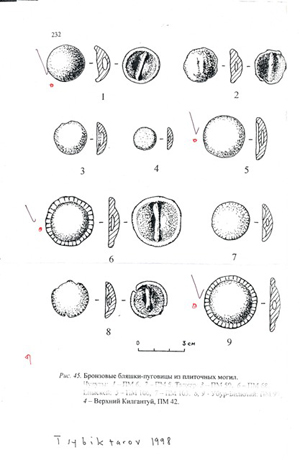 |
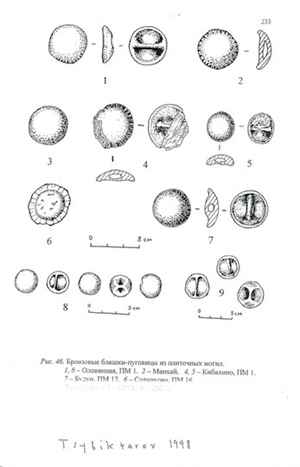 |
| Slab Grave culture copper alloy objects – 1 | Slab Grave culture copper alloy objects – 2 |
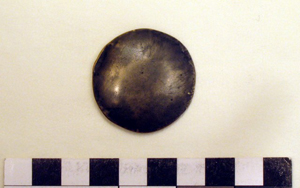 |
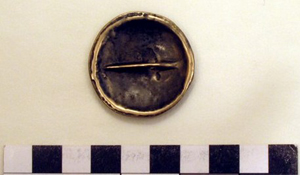 |
| thog-lcags 1a | thog-lcags 1b |
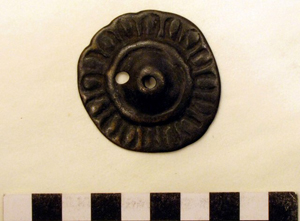 |
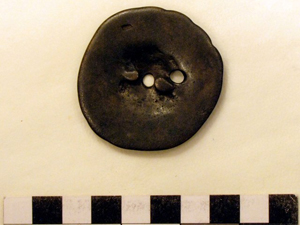 |
| thog-lcags 2a | thog-lcags 2b |
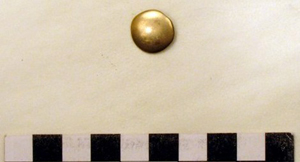 |
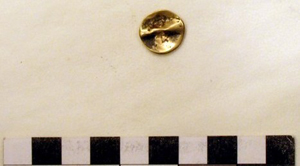 |
| thog-lcags 3a | thog-lcags 3b |
Set 2
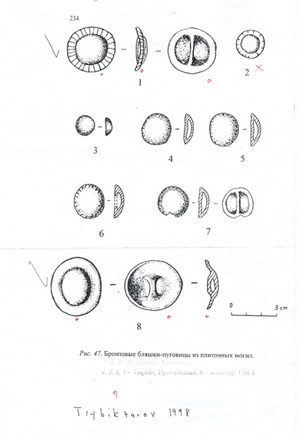 |
|
| Slab Grave culture copper alloy objects – 3 | |
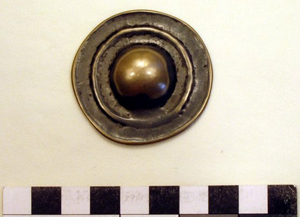 |
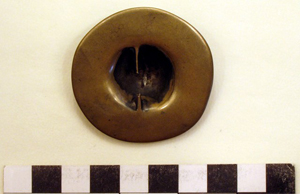 |
| thog-lcags 4a | thog-lcags 4b |
Set 3
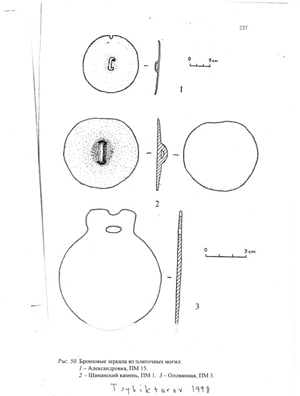 |
|
| Slab Grave culture objects – 4 | |
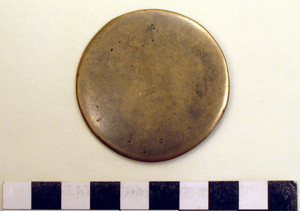 |
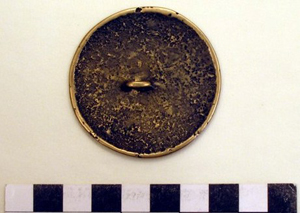 |
| thog-lcags 5a | thog-lcags 5b |
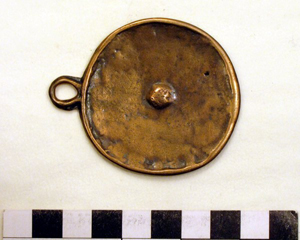 |
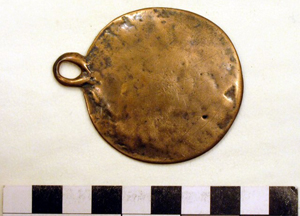 |
| thog-lcags 6a | thog-lcags 6b |